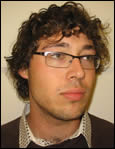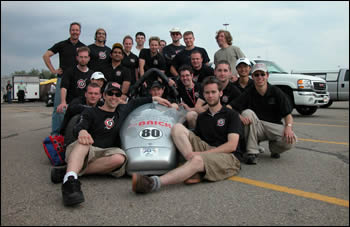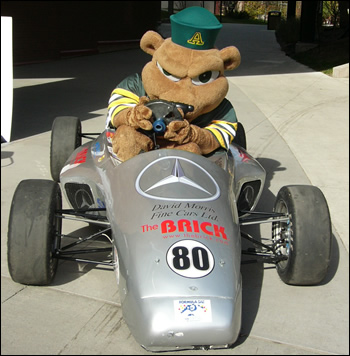|

______________________
BY JOSH KJENNER
University of Alberta
Student Contributor
(Engineering)
______________________ |
 |
The life of an engineering student is a hectic one. Between
completing five assignments a week, working on design projects
and polishing up the good
ol’ pocket
protector, the typical engineering pupil has a lot to do.
A brave few, however, elect to balance their technical education
with experience in various extracurricular arenas. The athletes
play intramurals, the nerds write articles — and those
interested in race cars join the Formula SAE team.
Everett Marshall, Anson Wong and Lindsay Smith are three
such students. Everett, a fifth-year mechanical engineering
student, is the 2006 design director for the team. Anson is
a third-year mechanical student who occupies the role of 2005
modification leader. And Lindsay, a fourth-year business student,
is the 2005 administration director.
 |
Everyone Wants on the Team
Above, Formula SAE team members pose with their wheels. Right, the U of
A mascot takes a turn behind the wheel. |
 |
| |
They are three of over 70 students — made up of roughly
85 per cent engineering students and 15 per cent engineering
student admirers — involved in the Formula SAE team.
The team exists to “design and build a small-scale weekend
autocross vehicle” for the purpose of competing with
140 other schools in the Society of Automotive Engineers’ annual
competition in Detroit, says Lindsay. Formula, as the members
call it, is one of the newer student vehicle projects
at the U of A. The team sent its first vehicle to Detroit
in 1999, and after taking a one-year break in 2000 has sent
one every year since.
The team has quickly grown and now has a yearly budget of
approximately $60,000. Most of the funding is outside sponsorship,
Lindsay says, although the team does receive roughly one-sixth
of its budget from the university. The rest of the budget
is received from companies across Edmonton, which have helped
to build the team into what it is today.
“Historically, we’ve done pretty well,”
says Everett. “The first time we went we finished 36th.”
Although the team has been unable to duplicate this success,
it has typically finished in the 50s or 60s, which is quite
respectable considering the competition consists largely of
American teams with superior funding.
Last year the team didn’t place as high as hoped,
but the team endured a lot of what Everett calls bad luck
— the results of which were a suspension failure and
chronic overheating.
The outlook, however, is optimistic. This year, the team
went through a major shift in moving from a one-year design
cycle
to two years. This will enable the team to design the car
one year and build it and test the next, “instead of
trying to do everything in one year,” says Lindsay.
One arm of the team, under the leadership of Wong, will modify
and improve last year’s car for competition, while another
arm, under Marshall, will begin preparing for the competition
in 2006. The design for the 2007 car will begin next year,
meaning the team will always be working on two cars simultaneously.
The new system results in essentially twice as much work,
as if these students weren’t busy enough already. If
the students want to have a car ready for 2006, those pocket
protectors might be going unpolished.
|

